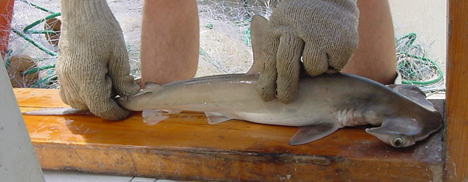Reproduction and Life History
The reproduction methods of the Sphyrna lewini is
nothing out of the ordinary. Males and females reproduce
sexually, leading to embryos in the female. Because
there really isn’t anything outstanding about the
reproduction of this species, there is not much
information available on the subject.
As I have state above, scalloped hammerhead
sharks reproduce sexually and the product is a
fertilized egg. Gestation usually ranges between 9 and
10 months with litters usually containing 12-34 pups
(Duncan et al. 2006). There are not any known unique
required specific conditions needed for reproduction.
Once the litter is born, they are not raised by
the parents. They are laid together in warm, shallow
waters such as the bay or estuaries and form nurseries
there until maturity (White et al. 2008). Maturity is
measured differently for males and females. For males,
it is when their claspers become fully calcified, which
are just a segment of the abdomen found on males (White
et al. 2008). Females are actually much larger in size
at maturity. This is does make sense however, given that
females typically reach maturity around the age of 15
years while males do around 6 years old (Myers et al.
2013). Their maturity determination is reproductive
organ based, as in their uteri development (White et al.
2008). Once they do
reach maturity, they go off shore and join schools of
large numbers.
